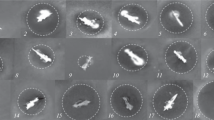Abstract
The results of a study of the polymorphism of intracellular isoenzymes in cultures of Schizophyllum commune Fr. grown in the Donetsk region are presented here. The electrophoretic spectra of AMY, ADH, GPDH, GDH, SDH, and EST are described and given in the paper. Enzyme systems, such as ADH, GPDH, and GDH, were found to be monomorphic. The EST enzyme showed the highest intracellular isoform diversity. Six obviously distinguished zones were found for this enzyme. Polymorphism is inherent for three of them.
Similar content being viewed by others
References
Korshikov, I.I., Mudrik, O.A., Lisnichuk, A.M., and Velikorid’ko, T.I., Analysis of Genetic Homogeneity of Relic Populations of Pinus sylvestris L. and Pinus sylvestris var. cretacea Kalenicz. ex Kom. in Ukraine, Ukr. Bot. Zh., 2006, no. 6, pp. 845–852.
Milyutina, D.I., Genotypic Composition of Populations and Resistance to Some Fungicides of Phytophtora infestans (Mont.) de Bary Strains from Mari El Republic and Moscow Region, Extended Abstract of Candidate’s (Biol.) Dissertation, Moscow, 2008.
Shnyreva, A.V., Genosystematics and the Problem of Species in Fungi, Immunopatologiya, 2009, no. 1, pp. 13–15.
McDonald, B.A., The Population Genetics of Fungi: Tools and Techniques, Phytopathology, 1997, pp. 448–453.
Royse, D.J. and May, B., Identification and Use of Three New Biochemical Markers in Agaricus bisporus, Agric. Biol. Chem., 1989, pp. 2861–2866.
Sozinov, A.A., Polimorfizm belkov i ego znachenie v genetike i selektsii (Protein Polymorphism and Its Significance in Genetics and Breeding), Moscow: Nauka, 1985.
Zervakis, G., Sourdis, J., and Balis, C., Genetic Variability and Systematics of Eleven Pleurotus Species Based on Isoenzyme Analysis, Mycol. Res., 1994, pp. 329–341.
Urbanelli, S., Della, Rosa V., Fanelli, C., Fabbri, A., and Reverberi, M., Genetic Diversity and Population Structure of the Italian Fungi Belonging to the Taxa Pleurotus eryngii (DC.:Fr.) Que’l and Pleurotus ferulae (DC.:Fr.) Que’l, Heredity, 2003, pp. 253–259.
Shnyreva, A.V., Molecular Genotyping of Commercial Strains of Cultivated Edible Mushrooms, Shkola Gribovodstva, 2006, no. 4, pp. 48–51.
Cybertruffle’s Robigalia. Observations of Fungi and Their Associated Organisms [Electronic Resource]. http://www.cybertruffle.org.uk (05.07.09).
Zubkova, L.A. and Stepanova, A.A., Ultrastructure of the Basidia and Spores of Schizophyllum commune Fr.: Fr. (Schizophyllaceae) Depending on the Type of Substrate Mikol. Fitopatol., 1998, no. 2, pp. 48–53.
Linovits’ka, V.M. and Bukhalo, A.S., Cultural and Morphological Characteristics of the Medicinal Mushroom Schizophyllum commune Fr. (Basidiomycetes) Grown on Solid Nutrient Media, Ukr. Bot. Zh., 2005, no. 1, pp. 78–86.
Clarke, A.J. and Yaguchi, M., Difference Spectrophotometric Study on the Interaction of Cellulase from Schizophyllum commune with Substrate and Inhibitors, Biochim. Biophys. Acta, 1986, pp. 401–407.
Fowler, T.J., Mitton, M.F., Vaillancourt, L.J., and Raper, C.A., Changes in Mate Recognition through Alterations of Pheromones and Receptors in the Multisexual Mushroom Fungus Schizophyllum commune, Genetics, 2001, vol. 158, pp. 1491–1503.
Guettler, S., Jackson, E.N., Lucchese, S.A., Hanaas, L., Green, A., Hittinger, C.T., Tian, Y., Lilly, W.W., and Gathman, A.C., ESTs from the Basidiomycete Schizophyllum commune Grown on Nitrogen-Replete and Nitrogen-Limited Media, Fungal Genet. Biol., 2003, pp. 191–198.
Belova, N.V. and Efremova, I.Ya., Preparations from Higher Basidiomycetes — the Object of Patent and Legal Protection, Mikol. Fitopatol., 1992, vol. 26, no. 4, pp. 321–324.
Bilai, V.I., Osnovy obschey mikologii (Fundamentals of General Mycology), Kiev: Vishcha Shkola, 1980.
Metody eksperimental’noi mikologii (Methods of Experimental Mycology), Bilai, V.I., Ed., Kiev: Naukova dumka, 1982.
Osterman, L.A., Metody issledovaniya belkov i nukleinovykh kislot: Elektroforez i ul’tratsentrifugirovanie (prakticheskoe posobie) (Methods of Studying Proteins and Nucleic Acids: Electrophoresis and Ultracentrifugation (Practical Guide)), Moscow: Nauka, 1981.
Korochkin, L.I., Serov, O.L., and Pudovkin, A.I., Genetika izofermentov (Genetics of Isozymes), Moscow: Nauka, 1977.
Author information
Authors and Affiliations
Corresponding author
Additional information
Original Ukrainian Text © S.M. Boiko, 2011, published in Tsitologiya i Genetika, 2011, Vol. 45, No. 6, pp. 48–52.
About this article
Cite this article
Boiko, S.M. Polymorphism of intracellular isoenzymes of Schizophyllum commune Fr. (Basidiomycetes) in the Donetsk region. Cytol. Genet. 45, 343–346 (2011). https://doi.org/10.3103/S0095452711060016
Received:
Published:
Issue Date:
DOI: https://doi.org/10.3103/S0095452711060016



